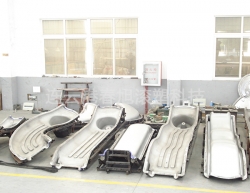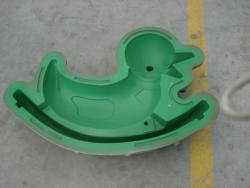Rotary Molding Industry Development Overview
date::2016-07-27 author: click:
Rotational molding originated in Britain in 1934. Since the 1940s, European polyvinyl chloride pastes have been used to produce toys such as plastic balls by rotomolding molding. In the 1950s, a polyethylene rotomolding process using low-density polyethylene powdered resins was developed to produce industrial products such as polyethylene storage tanks and large-sized pipes, which greatly promoted the development of rotomoulding processes. Since then, nylon, polycarbonate, ABS and other plastics have also been molded by rotomolding.
In the 1960s, due to the continuous improvement of resin properties and rotomolding equipment, the rotational molding process was rapidly developed. In foreign countries, a number of special plastics for rotomolding have been developed, such as PE P-320 and Raychems Flamolin 771, developed by Union Carbide. PE P-320 is a low density polyethylene that combines the good flow molding properties of low density polyethylene resins with the low temperature impact toughness, chemical resistance, and stress crack resistance of high density polyethylene resins; Raychems F1amo1in 711 is a The cross-linked polyethylene resin for rotomolding, in addition to being cross-linkable, also has self-extinguishing properties. Philippe's famous rotomolded grade cross-linked polyethylene resin Marlex Cl-100 was also developed during this time.
In order to adapt to the needs of preparing large-scale rotomoulded products, in the late 1960s, many machines were also developed that can effectively use the floor space and thermal energy to perform rotomolding on large plastic parts. By 1970, more than half of the rotomoulding machines in commercial rotomoulding machines had a rotary diameter in excess of 1.75m. In addition, the machine's control level has also been improved to varying degrees. For example, the three-arm rotational molding machine McNeil Auronis model 3000-200 can control the heating and cooling cycles of each arm separately so that simultaneously rotomoulding products of different sizes and different materials. The rotary diameter is up to 5m. The total weight of the mold and resin that each arm can bear is about 13,500N. The jacket type rotomolding machine with good heat transfer effect and small footprint is also designed and manufactured during this time.
In the early 1970s, more than 50 companies in the UK had been involved in the production of rotomolded products, with more than 70 rotomoulded thermoplastics manufacturers; more than 20 companies in the European continent were involved in rotomolding, including Germany and France. Companies in Italy, Switzerland, Norway, Austria, Denmark, etc. The United Kingdom has been able to provide rotomoulding machines capable of producing containers with a capacity of 18,000L. The Netherlands has produced large cylindrical storage tanks with a diameter of 2.1m and a length of 4.8m. The storage tank is 540kg and its wall thickness is 25mm. At that time, the total amount of rotomolding products in Europe had reached more than 15,000 tons, of which only 7,000 tons were in the United Kingdom alone. In the early 1970s, there were more than 500 companies in the United States that were involved in the production of rotomolded products. With more than 500 rotomoulding machines, the capacity of rotomoulded containers has exceeded 10,000 liters (2,400 gallons); the largest rotomoulding machine can produce Plastic parts up to 4.6×4.6×2.1m.
Rotational molding has undergone three major developments in the 1950s, the 1970s, the 1980s and the early 1990s. It has been quite developed in Western Europe and North America, forming a rotomolding raw material professional company to produce and formulate, rotomolding machinery and equipment. The professional company manufactures and sells an independent industrial system consisting of rotomolding technology, scientific research and education, and a large number of rotomolding factories. All thermoplastic resins and some thermosetting resins can be used to produce products as small as table tennis, up to 85 meters in volume, in various shapes, as a whole, seamless, once formed. Rotational molding industry has become a large-scale plastic molding industry. By 1992, the resin used for rotational molding in the world accounted for 8-9% of the total resin consumption in the world. There were more than 5,000 kinds of rotational molding products registered in the United States Rotational Molding Association. There are currently about 1,000 rotomoulding enterprises in the world. The International Rotational Molding Association (ARM) based in the United States, as the main international organization in the rotomolding industry, has members in 58 countries, including rotomolding product manufacturers, raw material suppliers, and mold design manufacturers.
tags:Rotationalmouldmanufacturers
Related Products:
related news:
- The application of rotomolding process is bound to become the mainstream
- Understanding rotomolding
- Simple introduction of rotomolding
- Simple introduction to the process of rotomoulding product processing
- Rotational process characteristics
- Development Overview of Rotational Molding Industry in China
- The future of rotomolding industry
- Rotational molding technology gradually becomes a hot process
- What is rotomolding?
- Rotational molding and its use in industry














